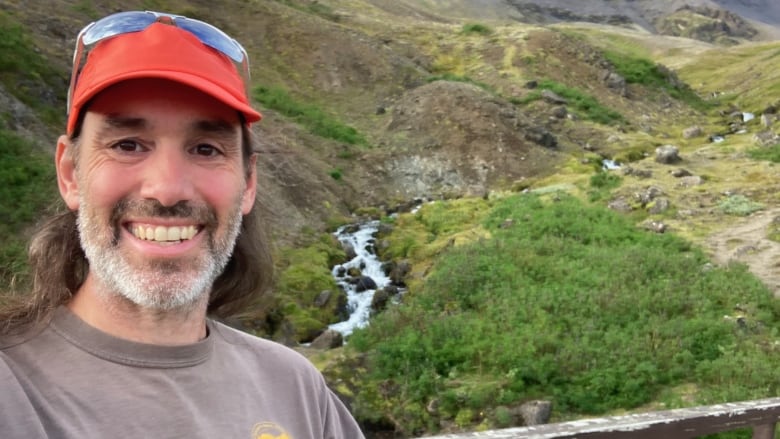Researchers pooling data to make nature more predictable, sooner

Before starting your day — deciding on an activity or how to dress for the elements — you might do the same thing Michael Dietze does.
"I pick up my phone and check the weather forecast at least once or twice a day to see what's likely to come," he said.
Dietze dedicates his time working on the type of forecasting that's commonplace for the weather, but to help handle other environmental challenges, as a professor leading the Ecological Forecasting Laboratory at Boston University.
Traditionally, environmental management references stable norms, such as well-established wildlife habitats or a 50-year flood, said Dietze.
However, with climate change, Dietze says those benchmarks are becoming obsolete, and people shouldn't think we're now in a "new normal" when it's more like a "state of continuous readjustment."
"And so if your baselines are changing on a continuous basis, you have to take a new approach to … environmental management."
That new approach includes "ecological forecasts" — looking at a multitude of scenarios and problems — which can help us adapt to the unpredictability around us proactively, rather than reactively.
A multitude of models interact
It's an approach Frances Stewart, assistant professor at Wilfrid Laurier University and Canada Research Chair in Northern Wildlife Biology, is taking in her collaborative work on wildlife.
If you take the concept of a weather forecast, she said, you are starting with many different models — such as temperature, precipitation, wind changes and more. However, it's how those things interact that allows us to project what conditions will look like hours or days away.
"But unless those models are able to talk to each other, you don't have a forecast, you don't have a radar map, you don't have trend lines or predictions of what might happen the next day. We're starting to be able to do the same thing in ecology, and we're able to do it quickly, easily, repeatedly."
Building a forecast to help threatened boreal caribou
In a recent paper, Stewart and her colleagues apply this concept to boreal caribou habitat in the Northwest Territories. To do so, they included different predictions about boreal caribou habitat in a computer program to create a projection, or forecast, of how these things will interact in the coming century.
Stewart said by combining predictions about climate change, wildfires, and how tree species composition might shift and change, they were able to create a forecast of the Northwest Territories boreal habitat. Their results paint a mixed picture for the future.
"It's pretty much an OK news story. What we're seeing is that there will be large shifts in the northern boreal forest and that's going to affect where caribou are expected to be found," said Stewart.
Overall, their forecast shows that the amount of boreal caribou habitat in the Northwest Territories will slightly decline by the end of the century. However, it also shows that remaining habitat is likely to push northward than it is currently, which Stewart said provides an opportunity to think about both the present and the future of boreal caribou conservation.
Governments and wildlife managers can look at these forecasts and consider "the tradeoff between conserving where caribou are today and conserving where caribou might be tomorrow, whether that's conservation through things such as protected areas or changes in hunting regulations," said Stewart. Or, in the case of where boreal caribou habitat is shifting, leaving those lands intact and undeveloped in anticipation of the species' arrival as the planet continues to warm.
Boreal caribou are listed as threatened under the federal Species at Risk Act. Governments responsible for managing these herds must work to "conserve or protect" 65 per cent of habitat within each range.
The Wek'èezhìı range, co-managed by the Tlicho Government, North Slave Métis Alliance, and the government of Northwest Territories, was included in Stewart's recent paper.
For Stephanie Behrens, a wildlife biologist with the Tlicho Government and Tlicho citizen, the boreal caribou forecasts are "a very useful tool" in protecting boreal caribou in the Northwest Territories.

While the species is considered "threatened," the motivation to protect them goes beyond the legal mandate.
"For the Tlicho people, hunting and harvesting Todzi [boreal caribou] has been a part of our everyday way of life since time immemorial and ensuring that we have enough to sustainably harvest for now and for the future generations is essential to maintaining the Tlicho culture," she said.
Behrens and her team have also worked on their own predictions with climate change in mind. Western science is an important component of their range planning, but doesn't displace the need to gather and include the knowledge that exists in the community.
"I really [want] to stress the importance of implementing traditional knowledge with this type of work and how it complements the science side of it," she said.
Community is key to success
For Michael Dietze, working with communities is central to ecological forecasting being successful and more widely integrated. More forecasting projects are taking this collaborative approach.
Without involving the people who could benefit from the forecasts about what to include and how they would be used, Dietze said scientists run the risk of their work not being useful in practice.
"I think it's really important to have those partnerships between end users and the forecasting community, that's really one of the biggest limiting factors in scaling out ecological forecasting," he said.
Eventually, Dietze wants to see this scaled up to the point that it's a "common part of everyday life" in the same way that a weather forecast is. His lab has partnered with communities to include work on monitoring a lake and forecasting for ticks.

For one of his lab's projects, there has been collaboration on a tick forecast with researchers from the northeastern United States. In North America, climate change is increasing the risk of illness from tick bites, such as Lyme disease from blacklegged ticks in southcentral and Eastern Canada.
Living in Massachusetts, Dietze imagines a tick forecast being as readily available as checking the weather. For example,consulting it before his kids' soccer or softball practice to know how likely they would be to encounter ticks on the sports field that day. Or, similarly for planning a hike.
Dietze is collaborating with other researchers on a forecast for Lake Sunapee in New Hampshire to measure toxic algal blooms, which can cause illness in people and animals. Climate change is bringing conditions that make these outbreaks more likely, such as warmer water.
"To be able to plan a trip to the beach in advance and have the ability to check what's the likelihood that there's going to be an algal bloom … maybe I'll go to a different beach or maybe I'll put this off," Dietze said.
Another collaboration between Virginia Tech and the Western Virginia Water Authority is developing forecasts for reservoirs to anticipate drinking water issues.

If a water treatment facility can predict conditions, treatment options can be altered or the plant can be taken offline to stop intake, said Jamie Morris, water production manager for the authority.
The water authority is "seeing a lot of different changes with the climate," said Morris. Algal blooms, for example, which are increasing with climate change, can also contaminate drinking water sources.
"If you can predict when you might see an increase in algal bloom … if you have multiple sources that are feeding a certain area, you might be able to avoid bringing water in from one particular plant and put demand on a different plant," said Morris.
The trend of using forecasting to manage a suite of environmental challenges is growing worldwide with an Ecological Forecasting Initiative that includes countries worldwide, from Europe, to Australia and Canada.
How forecasting can inform conservation in Canada
In Canada, forecasting for wildlife conservation is just getting its start. Frances Stewart and her colleagues have created an online map to make their forecasts available to government officials, wildlife managers, scientists, or anyone else interested.
So far, they have various bird species and boreal caribou mapped in the Northwest Territories,. However, Stewart says it would be easy to create similar forecasts for wolves or moose in the same region.
The computer program Stewart and her colleagues used to create their forecasts is open source, which means it's available for other researchers to use to create more wildlife forecasts. It's a tool she thinks is especially useful in the context of Canada's promise to the United Nations to protect 30 per cent of land by 2030.
Research shows that current protected areas may not be sufficient as habitat changes due to global warming, with half of them in Canada unlikely to allow wildlife to make the leap to other areas as their habitat moves, a phenomenon scientists call range shift.
With new protected areas being designated in northern Canada, Stewart said it's "a critical area" to consider how climate change will alter the habitat of species the federal government wants to protect.
"Canada's north is also warming at two to four times the global average. So, by placing protected areas in regions today without considering what those regions are going to look like tomorrow, you risk not protecting effective areas for biodiversity conservation," said Stewart.
*****
Credit belongs to : www.cbc.ca
 MaharlikaNews | Canada Leading Online Filipino Newspaper Portal The No. 1 most engaged information website for Filipino – Canadian in Canada. MaharlikaNews.com received almost a quarter a million visitors in 2020.
MaharlikaNews | Canada Leading Online Filipino Newspaper Portal The No. 1 most engaged information website for Filipino – Canadian in Canada. MaharlikaNews.com received almost a quarter a million visitors in 2020.







